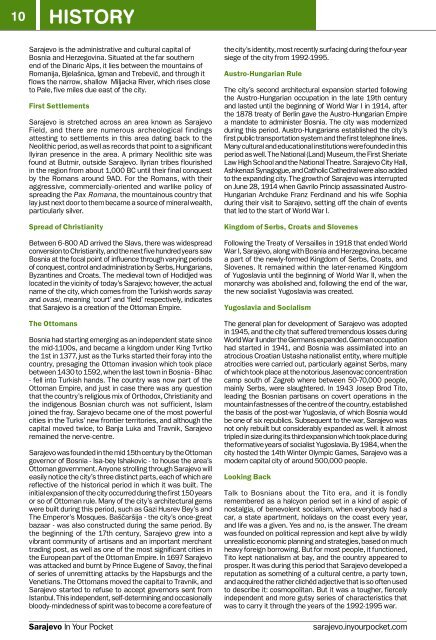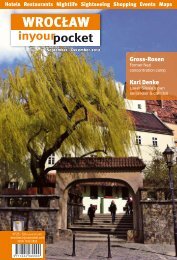SARAJEVO - In Your Pocket
SARAJEVO - In Your Pocket
SARAJEVO - In Your Pocket
Create successful ePaper yourself
Turn your PDF publications into a flip-book with our unique Google optimized e-Paper software.
10 history<br />
Sarajevo is the administrative and cultural capital of<br />
Bosnia and Herzegovina. Situated at the far southern<br />
end of the Dinaric Alps, it lies between the mountains of<br />
Romanija, Bjelašnica, Igman and Trebević, and through it<br />
flows the narrow, shallow Miljacka River, which rises close<br />
to Pale, five miles due east of the city.<br />
First Settlements<br />
Sarajevo is stretched across an area known as Sarajevo<br />
Field, and there are numerous archeological findings<br />
attesting to settlements in this area dating back to the<br />
Neolithic period, as well as records that point to a significant<br />
Ilyiran presence in the area. A primary Neolithic site was<br />
found at Butmir, outside Sarajevo. Ilyrian tribes flourished<br />
in the region from about 1,000 BC until their final conquest<br />
by the Romans around 9AD. For the Romans, with their<br />
aggressive, commercially-oriented and warlike policy of<br />
spreading the Pax Romana, the mountainous country that<br />
lay just next door to them became a source of mineral wealth,<br />
particularly silver.<br />
Spread of Christianity<br />
Between 6-800 AD arrived the Slavs, there was widespread<br />
conversion to Christianity, and the next five hundred years saw<br />
Bosnia at the focal point of influence through varying periods<br />
of conquest, control and administration by Serbs, Hungarians,<br />
Byzantines and Croats. The medieval town of Hodidjed was<br />
located in the vicinity of today’s Sarajevo; however, the actual<br />
name of the city, which comes from the Turkish words saray<br />
and ovasi, meaning ‘court’ and ‘field’ respectively, indicates<br />
that Sarajevo is a creation of the Ottoman Empire.<br />
The Ottomans<br />
Bosnia had starting emerging as an independent state since<br />
the mid-1100s, and became a kingdom under King Tvrtko<br />
the 1st in 1377, just as the Turks started their foray into the<br />
country, presaging the Ottoman invasion which took place<br />
between 1430 to 1592, when the last town in Bosnia - Bihac<br />
- fell into Turkish hands. The country was now part of the<br />
Ottoman Empire, and just in case there was any question<br />
that the country’s religious mix of Orthodox, Christianity and<br />
the indigenous Bosnian church was not sufficient, Islam<br />
joined the fray. Sarajevo became one of the most powerful<br />
cities in the Turks’ new frontier territories, and although the<br />
capital moved twice, to Banja Luka and Travnik, Sarajevo<br />
remained the nerve-centre.<br />
Sarajevo was founded in the mid 15th century by the Ottoman<br />
governor of Bosnia - Isa-bey Ishakovic - to house the area’s<br />
Ottoman government. Anyone strolling through Sarajevo will<br />
easily notice the city’s three distinct parts, each of which are<br />
reflective of the historical period in which it was built. The<br />
initial expansion of the city occurred during the first 150 years<br />
or so of Ottoman rule. Many of the city’s architectural gems<br />
were built during this period, such as Gazi Husrev Bey’s and<br />
The Emperor’s Mosques. Baščaršija - the city’s once-great<br />
bazaar - was also constructed during the same period. By<br />
the beginning of the 17th century, Sarajevo grew into a<br />
vibrant community of artisans and an important merchant<br />
trading post, as well as one of the most significant cities in<br />
the European part of the Ottoman Empire. <strong>In</strong> 1697 Sarajevo<br />
was attacked and burnt by Prince Eugene of Savoy, the final<br />
of series of unremitting attacks by the Hapsburgs and the<br />
Venetians. The Ottomans moved the capital to Travnik, and<br />
Sarajevo started to refuse to accept governors sent from<br />
Istanbul. This independent, self-determining and occasionally<br />
bloody-mindedness of spirit was to become a core feature of<br />
the city’s identity, most recently surfacing during the four-year<br />
siege of the city from 1992-1995.<br />
Austro-Hungarian Rule<br />
The city’s second architectural expansion started following<br />
the Austro-Hungarian occupation in the late 19th century<br />
and lasted until the beginning of World War I in 1914, after<br />
the 1878 treaty of Berlin gave the Austro-Hungarian Empire<br />
a mandate to administer Bosnia. The city was modernized<br />
during this period. Austro-Hungarians established the city’s<br />
first public transportation system and the first telephone lines.<br />
Many cultural and educational institutions were founded in this<br />
period as well. The National (Land) Museum, the First Sheriate<br />
Law High School and the National Theatre. Sarajevo City Hall,<br />
Ashkenazi Synagogue, and Catholic Cathedral were also added<br />
to the expanding city. The growth of Sarajevo was interrupted<br />
on June 28, 1914 when Gavrilo Princip assassinated Austro-<br />
Hungarian Archduke Franz Ferdinand and his wife Sophia<br />
during their visit to Sarajevo, setting off the chain of events<br />
that led to the start of World War I.<br />
Kingdom of Serbs, Croats and Slovenes<br />
Following the Treaty of Versailles in 1918 that ended World<br />
War I, Sarajevo, along with Bosnia and Herzegovina, became<br />
a part of the newly-formed Kingdom of Serbs, Croats, and<br />
Slovenes. It remained within the later-renamed Kingdom<br />
of Yugoslavia until the beginning of World War II, when the<br />
monarchy was abolished and, following the end of the war,<br />
the new socialist Yugoslavia was created.<br />
Yugoslavia and Socialism<br />
The general plan for development of Sarajevo was adopted<br />
in 1945, and the city that suffered tremendous losses during<br />
World War II under the Germans expanded. German occupation<br />
had started in 1941, and Bosnia was assimilated into an<br />
atrocious Croatian Ustasha nationalist entity, where multiple<br />
atrocities were carried out, particularly against Serbs, many<br />
of which took place at the notorious Jasenovac concentration<br />
camp south of Zagreb where between 50-70,000 people,<br />
mainly Serbs, were slaughtered. <strong>In</strong> 1943 Josep Brod Tito,<br />
leading the Bosnian partisans on covert operations in the<br />
mountain fastnesses of the centre of the country, established<br />
the basis of the post-war Yugoslavia, of which Bosnia would<br />
be one of six republics. Subsequent to the war, Sarajevo was<br />
not only rebuilt but considerably expanded as well. It almost<br />
tripled in size during its third expansion which took place during<br />
the formative years of socialist Yugoslavia. By 1984, when the<br />
city hosted the 14th Winter Olympic Games, Sarajevo was a<br />
modern capital city of around 500,000 people.<br />
Looking Back<br />
Talk to Bosnians about the Tito era, and it is fondly<br />
remembered as a halcyon period set in a kind of aspic of<br />
nostalgia, of benevolent socialism, when everybody had a<br />
car, a state apartment, holidays on the coast every year,<br />
and life was a given. Yes and no, is the answer. The dream<br />
was founded on political repression and kept alive by wildly<br />
unrealistic economic planning and strategies, based on much<br />
heavy foreign borrowing. But for most people, it functioned,<br />
Tito kept nationalism at bay, and the country appeared to<br />
prosper. It was during this period that Sarajevo developed a<br />
reputation as something of a cultural centre, a party town,<br />
and acquired the rather clichéd adjective that is so often used<br />
to describe it: cosmopolitan. But it was a tougher, fiercely<br />
independent and more gutsy series of characteristics that<br />
was to carry it through the years of the 1992-1995 war.<br />
Sarajevo <strong>In</strong> <strong>Your</strong> <strong>Pocket</strong> sarajevo.inyourpocket.com

















